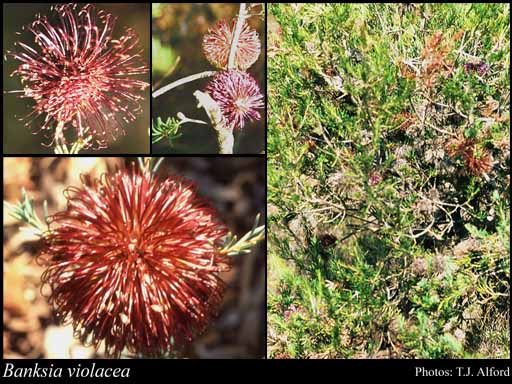- Reference
- J.Roy.Soc.Western Australia 13:62, Pl. 24K-O (1928)
- Conservation Code
- Not threatened
- Naturalised Status
- Native to Western Australia
- Name Status
- Current
Shrub, 0.2-2 m high, sometimes with lignotuber. Fl. violet/violet & green/green-yellow, May or Aug or Oct to Dec or Jan to Mar. White, yellow sand or sandy loam over laterite, clay or quartzite.

Scientific Description
Shrubs, 0.5-2 m high; branchlets glabrous or hairy. Leaves petiolate, alternate, 10-25 mm long, 1-1.5 mm wide, glabrous; petiole 1.5-2 mm long; lamina flat, more or less the same width throughout, entire, the margins revolute. Inflorescences tomentose (with matted or tangled, soft, woolly hairs), yellow, hairy. Perianth 17-26 mm long, hairy, all over, limb apex pubescent (with soft, straight, erect hairs), without awns; pistil 27-40 mm long, hooked, style glabrous. Follicles glabrous or hairy, pubescent (with soft, straight, erect hairs), elliptic, 10-25 mm long. Flowers in March, May, June, July or August. Occurs in the South-west (SW) Botanical Province(s), in the Geraldton Sandplains (GS), Avon Wheatbelt (AW), Mallee (MAL) or Esperance Plains (ESP) IBRA subregion(s).
Distribution
- IBRA Regions
- Avon Wheatbelt, Esperance Plains, Mallee.
- IBRA Subregions
- Fitzgerald, Katanning, Recherche, Western Mallee.
- IMCRA Regions
- WA South Coast.
- Local Government Areas (LGAs)
- Corrigin, Cranbrook, Dumbleyung, Esperance, Gnowangerup, Jerramungup, Kent, Kondinin, Kulin, Lake Grace, Pingelly, Plantagenet, Ravensthorpe, Wickepin, Woodanilling.